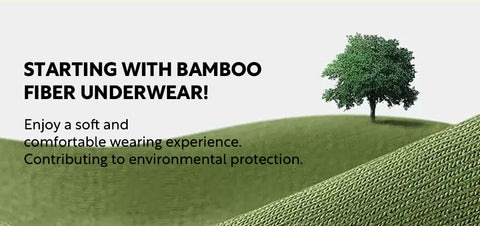In the quest for more sustainable lifestyles, consumers are turning their attention to all aspects of their consumption habits, including their choice of clothing. A key segment of the sustainable fashion movement is the rise of bamboo underwear, which represents both an eco-friendly alternative and a comfortable option for the conscious consumer. In this article, we will delve into how bamboo fabric is becoming a cornerstone in sustainable fashion and why it might just be the best choice for your next underwear purchase.
Understanding Sustainable Fashion
Sustainable fashion is about more than just the end product. It encompasses the entire lifecycle of an item of clothing, from the sourcing of materials to the manufacturing processes, and from the product’s longevity to its eventual biodegradability or recyclability. As the fashion industry is often highlighted for its environmental impact, consumers are advocating for change by choosing brands and materials that align with their values.
The Appeal of Bamboo as a Sustainable Resource
Bamboo is rapidly gaining popularity as a material for clothing, especially underwear, due to its sustainable properties. As a resource, bamboo is highly renewable – it grows quickly, requires no fertilisers, and regenerates from its own roots. These attributes make it a supercrop in the field of eco-friendly materials.
Bamboo’s Comfort Factor
When it comes to underwear, comfort is king. Bamboo fabric is known for its softness and breathability, which makes it an ideal choice for intimate apparel. The fibres of bamboo are naturally smooth and round, leading to a gentle, non-irritating feel against the skin. This is especially beneficial for those who have sensitive skin or allergies.
Moisture-Wicking and Thermal Regulating Properties
One of the many benefits of bamboo underwear is its ability to wick moisture away from the body, keeping the wearer dry and comfortable throughout the day. Bamboo fibre’s cross-section is filled with micro-holes and micro-gaps, allowing for better ventilation. Furthermore, it has exceptional thermal regulating properties, keeping you cooler in the summer and warmer in the winter, enhancing comfort in all climates.
The Eco-friendly Manufacturing Process
The method of transforming bamboo into soft fabric is becoming increasingly eco-friendly. Advances in processing technology allow for the use of closed-loop systems that recycle water and solvents, minimising waste and reducing the environmental footprint. As sustainability continues to influence consumer choices, the demand for environmentally responsible manufacturing methods grows, making the production of bamboo underwear even more appealing.
Longevity and Durability of Bamboo Underwear
Sustainability is not merely about the resources used; it also pertains to the longevity of the product. Bamboo fibres are strong and durable, meaning that bamboo underwear does not easily wear out. This durability translates to fewer replacements and less waste, further consolidating bamboo underwear’s position within sustainable fashion.
Biodegradability: A Closing Chapter in Sustainability
End-of-life disposal is an important aspect of a product’s sustainability. Bamboo is inherently biodegradable, breaking down naturally at the end of its life cycle, returning to the earth without leaving behind harmful residues. This gives bamboo underwear a significant advantage over synthetic alternatives that contribute to microplastic pollution.
Challenges in the Bamboo Underwear Market
Despite its many advantages, there are challenges to consider when it comes to bamboo underwear. The awareness about these sustainable options may still be limited, and mislabelling in the market can sometimes mislead consumers. It becomes important for buyers to do their research and choose transparent brands that are committed to ethical and eco-friendly practices.
READ MORE : The best things to do in San Jose del Cabo for a memorable trip
The Social Impact of Sustainable Underwear Choices
Choosing sustainable underwear doesn’t just benefit the environment; it often supports fair labour practices too. Many ethical bamboo underwear brands are committed to social responsibility, ensuring that their products are manufactured in a way that supports local communities and provides fair wages and safe working conditions for workers.
Bamboo Underwear and Style
The notion that sustainable fashion lacks variety or style is quickly becoming outdated. The market for bamboo underwear boasts a wide range of styles, colours, and designs to suit different tastes and preferences. Consumers no longer have to compromise on aesthetic appeal when making eco-conscious choices.
Consumer Responsibility and Education
As part of the move towards sustainable fashion, consumers have a responsibility to educate themselves on their purchasing decisions. Understanding the impact of different materials, the significance of certifications, and the practices of different brands can help in making informed choices that benefit both the individual and the planet.
Embracing Bamboo Underwear in Your Wardrobe
To truly embrace sustainability in fashion, one must consider the shift to materials like bamboo for everyday basics such as underwear. The comfort, eco-friendliness, and style that bamboo fabric offers make it an intelligent choice for those looking to reduce their environmental footprint while not sacrificing on personal comfort and aesthetics.
Conclusion
Sustainable fashion represents a movement towards a more conscientious way of living and manufacturing. The rise of materials such as bamboo indicates a market that is eager for change and brands that are willing to provide it. By choosing bamboo underwear, consumers can play an active role in this change, enjoying the comfort they bring while supporting the health of our planet.
Take Action
If you’re ready to take a step towards sustainability without compromising on comfort or style, consider exploring the options available for bamboo underwear. The choice may seem small, but it signifies a commitment to a larger movement that has the potential to shape the future of fashion, and indeed, the well-being of our environment.
